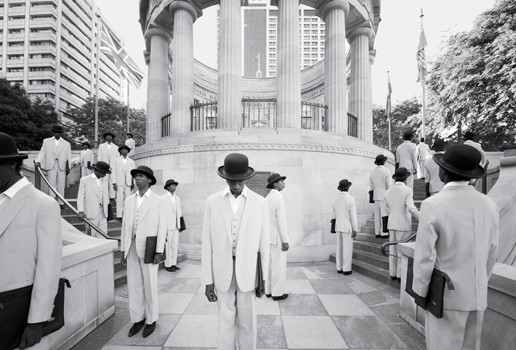AustLit
-
Memorial (2014), part of Cook’s 2014 series Majority Rule, is a strikingly choreographed black and white photograph that offers an alternative memory to Australia’s history. Majority Rule sees Cook depart aesthetically from the imagined colonial dreamtime of his previous series. Instead, he explores the monumental and everyday public spaces of our modern world, posing the question of how it would be if Australia’s Indigenous population were in the majority?
This work features the same characteristically Aboriginal model, digitally multiplied numerous times as he ascends and descends the steps of Brisbane’s ANZAC Square War Memorial. Opened in 1930, this photograph is reminiscent of a similar period, signified by its vintage black and white tonality as well as the men’s immaculate attire of bowler hats and homogenous white suits over white shirts and button up vests. Cook’s placement of the figures in an almost symmetrical manner corresponds to the circular design of the neo-classic memorial. Such order and composure, typical of Cook’s technique, has the power to demand the viewer’s attention, but as we stop and contemplate we are faced with an unusual sense of discomfort and melancholy.
Memorial’s sombre aesthetic lays in its ability to both transcend and acknowledge reality. Colonisation of Australia led to the decimation of the Indigenous population through massacres, Western introduced diseases, and malnutrition. Today, Australia’s Aborigines comprise a mere three-four percent of the total population. In reversing these statistics, Cook is imagining a modern Australia with Aborigines as the majority. But at the same time, by using a singular identity combined with iconic Western symbols, in the form of architectural monuments, clothing, and flags, he is showing that such a world will never be a reality.
With the centenary of the First World War (1914-1919) approaching, Memorial’s relevance is heightened. Approximately three to four hundred Aborigines served in the First Australian Imperial Force (AIF). Yet, despite their service, Aborigines have been excluded from the digger legend and on their return from war were faced with increased repression, discrimination, and exclusion. Cook attempts to make the viewer question such a history. He noted, “I was never taught Aboriginal history at school, only about European settlement of Australia. What I learnt … was similar to the first European settlers’ beliefs, with words like ‘natives’ and ‘discovery of Australia.’ Looking back now, I realise that it was a false way of teaching, and that it hid the truth about the treatment of Aborigines over the past four hundred years.”
Here, Cook populates the war memorial, a sacred territory devoted to returned servicemen, with an Aboriginal face. The lonesome figure that stands slightly off centre with his head bowed and eyes closed suggests grief for those who scarified their lives for a country who hadn’t yet recognised them as citizens. Each face appears contemplative, isolated, and solemn. With their heads turned different ways the figures never acknowledge one another or the viewer. Ultimately, Memorial is about a conversation, one that may challenge our ingrained belief systems.
You might be interested in...




